Improving the Effectiveness of Organisational Collaborative Innovation in Megaprojects: An Agent-Based Modelling Approach
Abstract
:1. Introduction
2. Literature Review
2.1. Collaborative Innovation in Megaprojects
2.2. Factors Influencing CIMP Behaviour
2.2.1. Innovation Environment
2.2.2. Innovation Network Organisations
2.2.3. Inter-Organisational Relationships
2.2.4. Innovation Resources Management
3. Methodology
3.1. Construction of the CIMP Basic Model
3.2. Model Programming
3.2.1. Parameter Settings
3.2.2. Running Rules
4. Simulations and Results
4.1. Innovative Environment as Variables
4.2. Innovation Network Organisational Power as a Variable
4.3. Inter-Organisational Evaluation Criteria as Variables
4.4. Behavioural Costs and Resource Absorption Capacity as Variables
5. Discussion
5.1. Theoretical Implications
5.2. Practical Implications
5.3. Limitations and Future Research Directions
6. Conclusions
Author Contributions
Funding
Conflicts of Interest
References
- Flyvbjerg, B. Introduction: The Iron Law of Megaproject Management. In The Oxford Handbook of Megaproject Management, 1st ed.; Flyvbjerg, B., Ed.; Oxford University Press: Oxford, UK, 2017; pp. 1–18. [Google Scholar]
- Flyvbjerg, B.; Garbuio, M.; Dan, L. Delusion and Deception in Large Infrastructure Projects: Two Models for Explaining and Preventing Executive Disaster. Calif. Manag. Rev. 2014, 51, 170–193. [Google Scholar] [CrossRef] [Green Version]
- Zeng, S.X.; Ma, H.Y.; Lin, H.; Zeng, R.C.; Tam, V. Social responsibility of major infrastructure projects in China. Int. J. Proj. Manag. 2015, 33, 537–548. [Google Scholar] [CrossRef]
- Slaughter, E.S. Models of Construction Innovation. J. Constr. Eng. Manag. 1998, 124, 226. [Google Scholar] [CrossRef]
- Davies, A.; Dodgson, M.J.; Gann, D.M. Innovation and flexibility in megaprojects: A new delivery model. In The Oxford Handbook of Megaproject Management, 3rd ed.; Flyvbjerg, B., Ed.; Oxford University Press: Oxford, UK, 2017; pp. 313–338. [Google Scholar]
- Pitsis, A.; Clegg, S.; Freeder, D.; Sankaran, S.; Burdon, S.; Drouin, N. Megaprojects Redefined—Complexity Versus Cost—and Social Imperatives. Int. J. Manag. Proj. Bus. 2018, 11, 7–34. [Google Scholar] [CrossRef]
- Veenswijk, M.; Marrewijk, A.V.; Boersma, K. Developing new knowledge in collaborative relationships in megaproject alliances: Organising reflection in the Dutch construction sector. Int. J. Knowl. Manag. 2010, 4, 216–232. [Google Scholar] [CrossRef] [Green Version]
- Herskovits, R.; Grijalbo, M.; Tafur, J. Understanding the main drivers of value creation in an open innovation program. Int. Entrep. Manag. J. 2013, 9, 631–640. [Google Scholar] [CrossRef] [Green Version]
- Kale, S.; Arditi, D. Innovation Diffusion Modeling in the Construction Industry. J. Constr. Eng. Manag. 2010, 136, 329–340. [Google Scholar] [CrossRef]
- Khang, D.B.; Moe, T.L. Success Criteria and Factors for International Development Projects: A Life-Cycle-Based Framework. Proj. Manag. J. 2008, 39, 72–84. [Google Scholar] [CrossRef]
- Davies, A.; Macaulay, S.; Debarro, T.; Thurston, M. Making Innovation Happen in a Megaproject: London’s Crossrail Suburban Railway System. Proj. Manag. J. 2015, 45, 25–37. [Google Scholar] [CrossRef]
- Justin, J.P.; Frans, A.J.; Volberda, H.W. Exploratory Innovation, Exploitative Innovation, and Performance: Effects of Organizational Antecedents and Environmental Moderators. Manag. Sci. 2006, 52, 1661–1674. [Google Scholar]
- Aronson, Z.H. An Investigation of the Role of Project Culture in Team Efficacy and Success in Project-Based Work. Int. J. Innov. Technol. 2015, 12, 1–18. [Google Scholar] [CrossRef]
- Jalal, M.P.; Shoar, S. A hybrid SD-DEMATEL approach to develop a delay model for construction projects. Eng. Constr. Archit. Manag. 2017, 24, 629–651. [Google Scholar] [CrossRef]
- Xie, L.; Han, T.; Chu, H.; Xia, B. Behavior Selection of Stakeholders toward Megaproject Social Responsibility: Perspective from Social Action Theory. Adv. Civ. Eng. 2019, 2019, 4956067. [Google Scholar] [CrossRef] [Green Version]
- Mu, W.; Bian, Y.Y.; Zhao, J.L. The role of online leadership in open collaborative innovation Evidence from blockchain open source projects. Ind. Manag. Data Syst. 2019, 119, 1969–1987. [Google Scholar] [CrossRef]
- Shi, Q.; Hertogh, M.; Bosch-Rekveldt, M.; Zhu, J.; Sheng, Z. Exploring Decision-Making Complexity in Major Infrastructure Projects: A Case Study From China. Proj. Manag. J. 2020, 51, 875697282091920. [Google Scholar] [CrossRef]
- Lehtinen, J.; Peltokorpi, A.; Artto, K. Megaprojects as organizational platforms and technology platforms for value creation. Int. J. Proj. Manag. 2019, 37, 43–58. [Google Scholar] [CrossRef]
- Chan, I.; Liu, A.; Fellows, R. Role of Leadership in Fostering an Innovation Climate in Construction Firms. J. Manag. Eng. 2014, 30, 06014003. [Google Scholar] [CrossRef]
- Zhang, R.; Wang, Z.; Tang, Y.; Zhan, Y. Collaborative Innovation for Sustainable Construction: The Case of an Industrial Construction Project Network. IEEE Access 2020, 8, 41403–41417. [Google Scholar] [CrossRef]
- Xue, X.; Zhang, R.; Wang, L.; Fan, H.; Yang, R.J.; Dai, J. Collaborative innovation in construction project: A social network perspective. KSCE J. Civ. Eng. 2018, 22, 417–427. [Google Scholar] [CrossRef]
- Brockmann, C.; Erbe, A.; Brezinski, H. Innovation in Construction Megaprojects. Technol. Anal. Strateg. 2016, 142, 04016059. [Google Scholar] [CrossRef] [Green Version]
- Chen, H.; Jin, Z.; Su, Q.; Yue, G. The roles of captains in megaproject innovation ecosystems: The case of the Hong Kong-Zhuhai-Macau Bridge. Eng. Constr. Archit. Manag. 2020, 28, 662–680. [Google Scholar] [CrossRef]
- Hetemi, E.; Ordieres, J.; Nuur, C. Inter-organisational collaboration and knowledge-work: A contingency framework and evidence from a megaproject in Spain. Knowl. Manag. Res. Pract. 2022. [CrossRef]
- Xue, J.; Shen, G.Q.; Yang, R.J.; Zafar, I.; Ekanayake, E.M.A.C.; Lin, X.; Darko, A. Influence of formal and informal stakeholder relationship on megaproject performance: A case of China. Eng. Constr. Archit. Manag. 2020, 27, 1505–1531. [Google Scholar] [CrossRef]
- Deng, B.; Xie, W.; Cheng, F.; Deng, J.; Long, L. Complexity Relationship between Power and Trust in Hybrid Megaproject Governance: The Structural Equation Modelling Approach. Complexity 2021, 2021, 8814630. [Google Scholar] [CrossRef]
- Pardo, M.; Coronado, W.F. Agent-based Modeling and Simulation to Adoption Process of Information Technologies in Health Systems. IEEE Lat. Am. Trans. 2016, 14, 3358–3363. [Google Scholar] [CrossRef]
- Zhao, N.; An, S. Collaborative Management of Complex Major Construction Projects: AnyLogic-Based Simulation Modelling. Discret. Dyn. Nat. Soc. 2016, 2016, 6195673. [Google Scholar] [CrossRef]
- Zhang, J.; Qiu, Y. How does the improved DB mode degrade the complex integrity of infrastructure mega-projects? Evidence from the Hong Kong-Zhuhai-Macao Bridge project in China. Front. Eng. Manag. 2018, 5, 40–51. [Google Scholar]
- Dubois, A.; Gadde, L. The construction industry as a loosely coupled system: Implications for productivity and innovation. Constr. Manag. Econ. 2002, 20, 621–631. [Google Scholar] [CrossRef]
- Zhu, Y.; Zhang, J.; Gao, X. Construction management and technical innovation of the main project of Hong Kong–Zhuhai–Macao Bridge. Front. Eng. Manag. 2018, 2018, 128–132. [Google Scholar] [CrossRef]
- Dietrich, P.; Eskerod, P.; Dalcher, D.; Sandhawalia, B. The Dynamics of Collaboration in Multipartner Projects. Proj. Manag. J. 2010, 41, 59–78. [Google Scholar] [CrossRef]
- Barutha, P.J.; Jeong, H.D.; Gransberg, D.D.; Touran, A. Evaluation of the Impact of Collaboration and Integration on Performance of Industrial Projects. J. Manag. Eng. 2021, 37, 04021037. [Google Scholar] [CrossRef]
- Nam, C.H.; Tatum, C.B. Leaders and champions for construction innovation. Constr. Manag. Econ. 1997, 15, 259–270. [Google Scholar] [CrossRef]
- Nam, C.H.; Tatum, C.B. Strategies for Technology Push: Lessons from Construction Innovations. J. Constr. Eng. Manag. 1992, 118, 507–524. [Google Scholar] [CrossRef]
- Zeng, S.X.; Chen, H.; Jin, Z.; Quanke, S.U. The Evolution of Mega project Innovation Ecosystem and Enhancement of Innovative Capability. Manag. World 2019, 35, 28–38. [Google Scholar]
- Hampson, K.D.; Manley, K. Construction innovation and public policy in Australia. In Innovation in Construction: An International Review of Public Policies, 5th ed.; Spon Press: London, UK, 2001; pp. 31–59. [Google Scholar]
- Laberge, Y. Book Review: Culture’s Consequences: Comparing Values, Behaviors, Institutions and Organizations across Nations. Sociol. Res. Online 2004, 9, 1. [Google Scholar] [CrossRef]
- Zhao, H. Organizational Innovation Climate and Performance: Based on the Intermediation of Innovative Behavior. In Proceedings of the 19th International Conference on Industrial Engineering and Engineering Management, Changsha, China, 27–29 October 2012. [Google Scholar]
- Se Rgeeva, N.; Zanello, C. Championing and promoting innovation in UK megaprojects. Int. J. Proj. Manag. 2018, 36, 1068–1081. [Google Scholar] [CrossRef]
- Clegg, S.R.; Veenswijk, M.; Pitsis, T.S.; Marrewijk, A.V. Managing public–private megaprojects: Paradoxes, complexity, and project design. Int. J. Proj. Manag. 2008, 26, 591–600. [Google Scholar]
- Winch, G.M. Three domains of project organising. Int. J. Proj. Manag. 2014, 32, 721–731. [Google Scholar] [CrossRef]
- Tang, Y.; Wang, G.; Li, H.; Cao, D. Dynamics of Collaborative Networks between Contractors and Subcontractors in the Construction Industry: Evidence from National Quality Award Projects in China. J. Constr. Eng. Manag. 2018, 144, 05018009. [Google Scholar] [CrossRef]
- Lehtonen, M. Evaluating megaprojects: From the “iron triangle” to network mapping. Evaluation 2014, 20, 278–295. [Google Scholar] [CrossRef] [Green Version]
- Han, Y.; Li, Y.; Rao, P.; Taylor, J.E. Global Collaborative Network of Skyscraper Projects from 1990 to 2010: Temporal Evolution and Spatial Characteristics. J. Constr. Eng. Manag. 2021, 147, 04021095. [Google Scholar] [CrossRef]
- Han, Y.; Li, Y.; John, E.T.; Zhong, J. Characteristics and Evolution of Innovative Collaboration Networks in Architecture, Engineering, and Construction: Study of National Prize-Winning Projects in China. J. Constr. Eng. Manag. 2018, 144, 04018038. [Google Scholar] [CrossRef]
- Dulaimi, M.; Ling, F.; Bajracharya, A. Organizational motivation and inter-organizational interaction in construction innovation in Singapore. Constr. Manag. Econ. 2003, 21, 307–318. [Google Scholar] [CrossRef]
- Ozorhon, B.; Karatas, C.G.; Demirkesen, S. A Web-Based Database System for Managing Construction Project Knowledge. Procedia Soc. Behav. Sci. 2014, 119, 377–386. [Google Scholar] [CrossRef] [Green Version]
- Kadefors, A.; Bjoerlingson, E.; Karlsson, A. Procuring service innovations: Contractor selection for partnering projects. Int. J. Proj. Manag. 2007, 25, 375–385. [Google Scholar] [CrossRef]
- Blayse, A.M.; Manley, K. Key influences on construction innovation. Constr. Innov. 2004, 4, 143–154. [Google Scholar] [CrossRef] [Green Version]
- Barlow, J. Innovation and learning in complex offshore construction projects. Res. Policy. 2000, 29, 973–989. [Google Scholar] [CrossRef]
- Amp, S.U.; Huber, C. How teams in networked organisations develop collaborative capability: Processes, critical incidents and success factors. Prod. Plan. Control 2011, 22, 488–500. [Google Scholar]
- Spekman, M.R. Characteristics of partnership success: Partnership attributes, communication behavior, and conflict resolution techniques. Strateg. Manag. J. 1994, 15, 135–152. [Google Scholar]
- Nunes, M.; Abreu, A. Managing Open Innovation Project Risks Based on a Social Network Analysis Perspective. Sustainability 2020, 12, 3132. [Google Scholar] [CrossRef]
- West, J.; Bogers, M. Leveraging External Sources of Innovation: A Review of Research on Open Innovation. J. Prod. Innov. Manag. 2014, 31, 814–831. [Google Scholar] [CrossRef]
- Chesbrough, H.W. Open Innovation: The New Imperative for Creating and Profiting from Technology by Henry Chesbrough. Acad. Manag. Perspect. 2006, 20, 86–88. [Google Scholar]
- Ahn, J.M.; Ju, Y.; Moon, T.H. Beyond absorptive capacity in open innovation process: The relationships between openness, capacities and firm performance. Technol. Anal. Strateg. 2016, 28, 1009–1028. [Google Scholar] [CrossRef] [Green Version]
- Patricia, C.; Herbert, R.; Ahmed, A.G.; Chimay, A. Knowledge management in UK construction: Strategies, resources and barriers. Proj. Manag. J. 2004, 35, 46–56. [Google Scholar]
- Meng, X. The effect of relationship management on project performance in construction. Int. J. Proj. Manag. 2012, 30, 188–198. [Google Scholar] [CrossRef]
- Drexler, J.A.; Larson, E.W. Partnering: Why Project Owner-Contractor Relationships Change. J. Constr. Eng. Manag. 2000, 126, 293–297. [Google Scholar] [CrossRef]
- Rutten, M.E.J.; Dorée, A.G.; Halman, J.I.M. Innovation and interorganizational cooperation: A synthesis of literature. Constr. Innov. 2009, 9, 285–297. [Google Scholar] [CrossRef]
- Hongquan, C.; Quanke, S.; Saixing, Z.; Daxin, S.; Jonathan, J.S. Avoiding the innovation island in infrastructure mega-project. Front. Eng. Manag. 2018, 5, 16. [Google Scholar]
- Garcia, R. Uses of Agent-Based Modeling in Innovation/New Product Development Research. J. Prod. Innov. Manag. 2005, 22, 380–398. [Google Scholar] [CrossRef]
- Macal, C.M.; North, M.J. Agent-based modeling and simulation. In Proceedings of the Winter Simulation Conference (WSC), Austin, TX, USA, 13–16 December 2009. [Google Scholar]
- Du, J.; El-Gafy, M. Using Agent-Based Modeling to Investigate Goal Incongruence Issues in Proposal Development: Case Study of an EPC Project. J. Manag. Eng. 2015, 31, 05014025. [Google Scholar] [CrossRef]
- Horii, T.; Jin, Y.; Levitt, R.E. Modeling and Analyzing Cultural Influences on Project Team Performance. Comput. Math. Organ. Theory 2005, 10, 305–321. [Google Scholar] [CrossRef]
- Gao, S.; Song, X.; Ding, R. Promoting Information Transfer in Collaborative Projects through Network Structure Adjustment. J. Constr. Eng. Manag. 2020, 146, 04019108. [Google Scholar] [CrossRef]
- Xiong, J.; Duan, Z.; Wang, Y. Modeling and Simulation of the Inter-Organizational Knowledge Transfer Impact Factors in Industrial Clusters. In Proceedings of the 19th International Conference on Industrial Engineering and Engineering Management, Changsha, China, 27–29 October 2012. [Google Scholar]
- Cheng, L.; Guo, H.; Lin, H. Evolutionary model of coal mine safety system based on multi-agent modeling. Process Saf. Environ. Prot. 2021, 147, 1193–1200. [Google Scholar] [CrossRef]
- Locatelli, G.; Mancini, M.; Romano, E. Systems Engineering to improve the governance in complex project environments. Int. J. Proj. Manag. 2014, 32, 1395–1410. [Google Scholar] [CrossRef]
- Tedeschi, G.; Vitali, S.; Gallegati, M. The dynamic of innovation networks: A switching model on technological change. J. Evol. Econ. 2014, 24, 817–834. [Google Scholar] [CrossRef]
- Toor, S.; Ofori, G. Developing Construction Professionals of the 21st Century: Renewed Vision for Leadership. J. Prof. Issues Eng. Educ. Pract. 2008, 134, 279–286. [Google Scholar] [CrossRef]
- Wang, T.; He, Q.; Lu, Y.; Yang, D. How Does Organizational Citizenship Behavior (OCB) Affect the performance of megaprojects? Insights from a System Dynamic Simulation. Sustainability 2018, 10, 1708. [Google Scholar] [CrossRef] [Green Version]
- Kieron, M.; Mark, R. Network density and R&D spillovers. J. Econ. Behav. Organ. 2004, 53, 237–260. [Google Scholar]
- Noktehdan, M.; Shahbazpour, M.; Zare, M.; Wilkinson, S. Innovation Management and Construction Phases in Infrastructure Projects. J. Constr. Eng. Manag. 2019, 145, 04018135. [Google Scholar] [CrossRef]
- Parolin, S.; Vasconcellos, E.; Volpato, M.; Laurindo, A.M. Barriers and Facilitators of Collaborative Management in Technological Innovation Projects. Int. J. Innov. Technol. 2013, 8, 85–86. [Google Scholar]
- Lu, Y.; Li, Y.; Cui, Q. Organizational Behavior and Governance of Megaprojects. J. Manag. Eng. 2020, 36, 02020001. [Google Scholar] [CrossRef] [Green Version]
- Blomqvist, K.; Levy, J. Collaboration Capability—A Focal Concept in Knowledge Creation and Collaborative Innovation in Networks. Int. J. Manag. Concepts Philos. 2013, 2, 31–48. [Google Scholar] [CrossRef]
- Wu, C.; Yao, H.; Ning, X.; Wang, L. Emergence of Informal Safety Leadership: A Social-ognitive Process for Accident Prevention. Prod. Oper. Manag. 2021, 30, 4288–4305. [Google Scholar] [CrossRef]
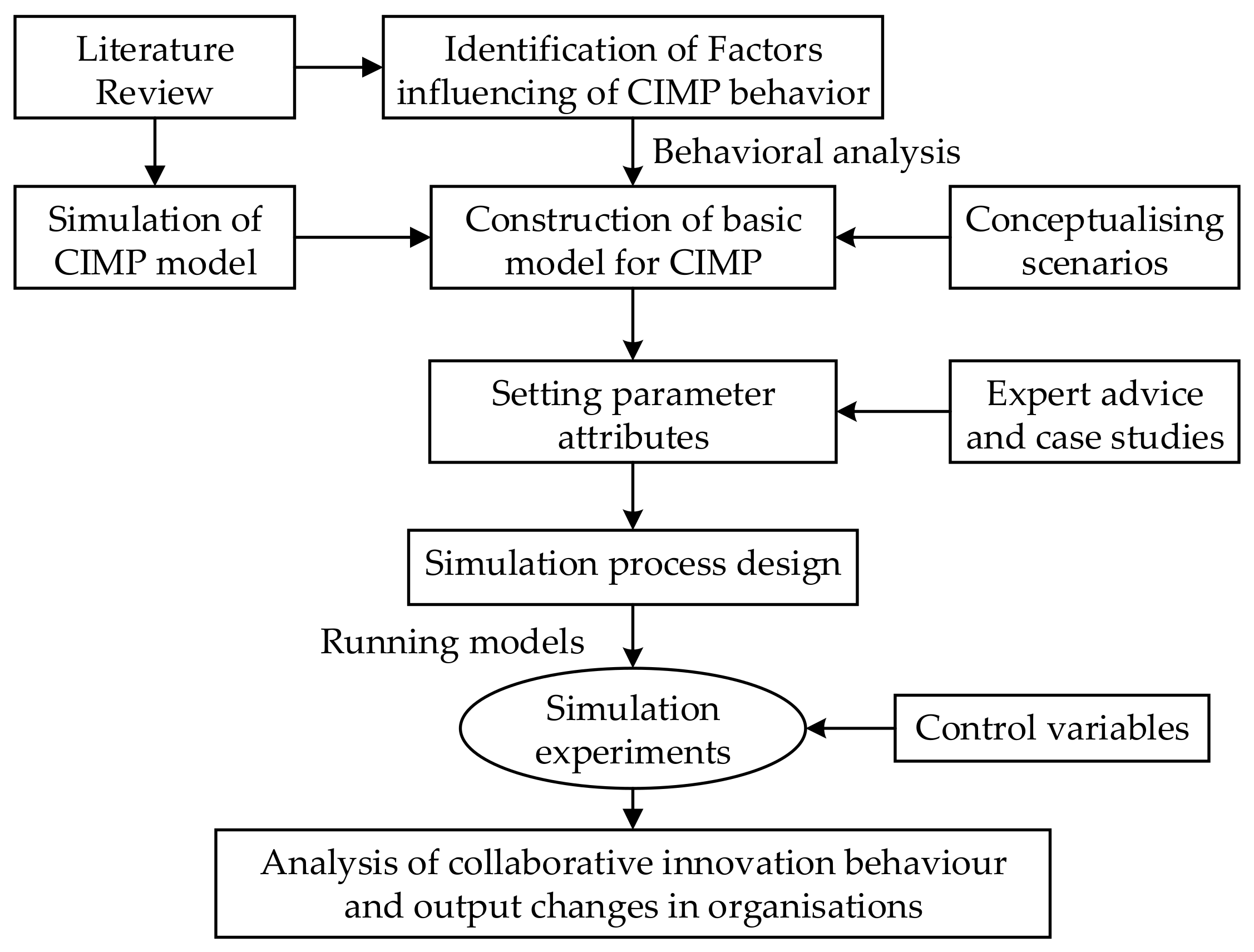

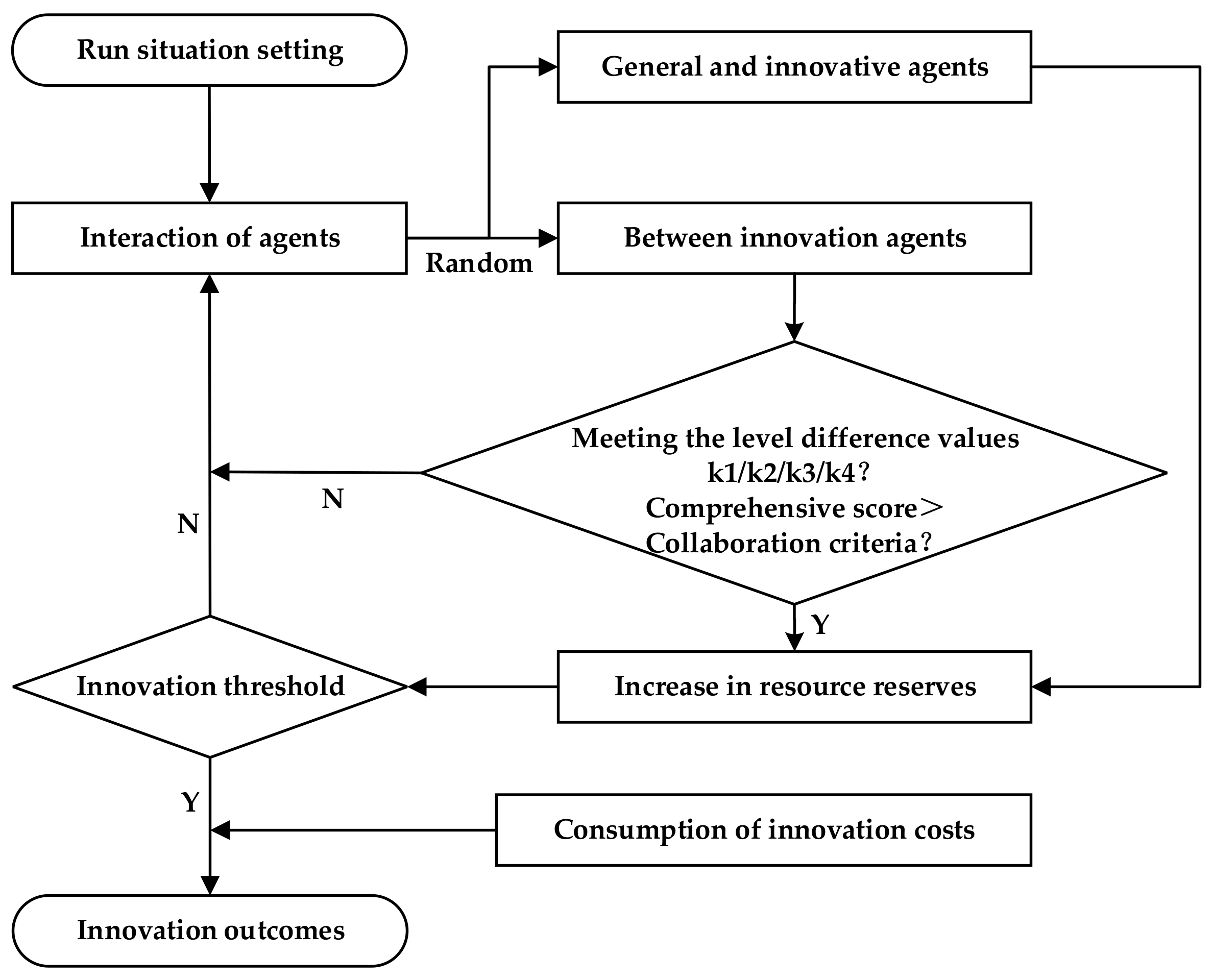

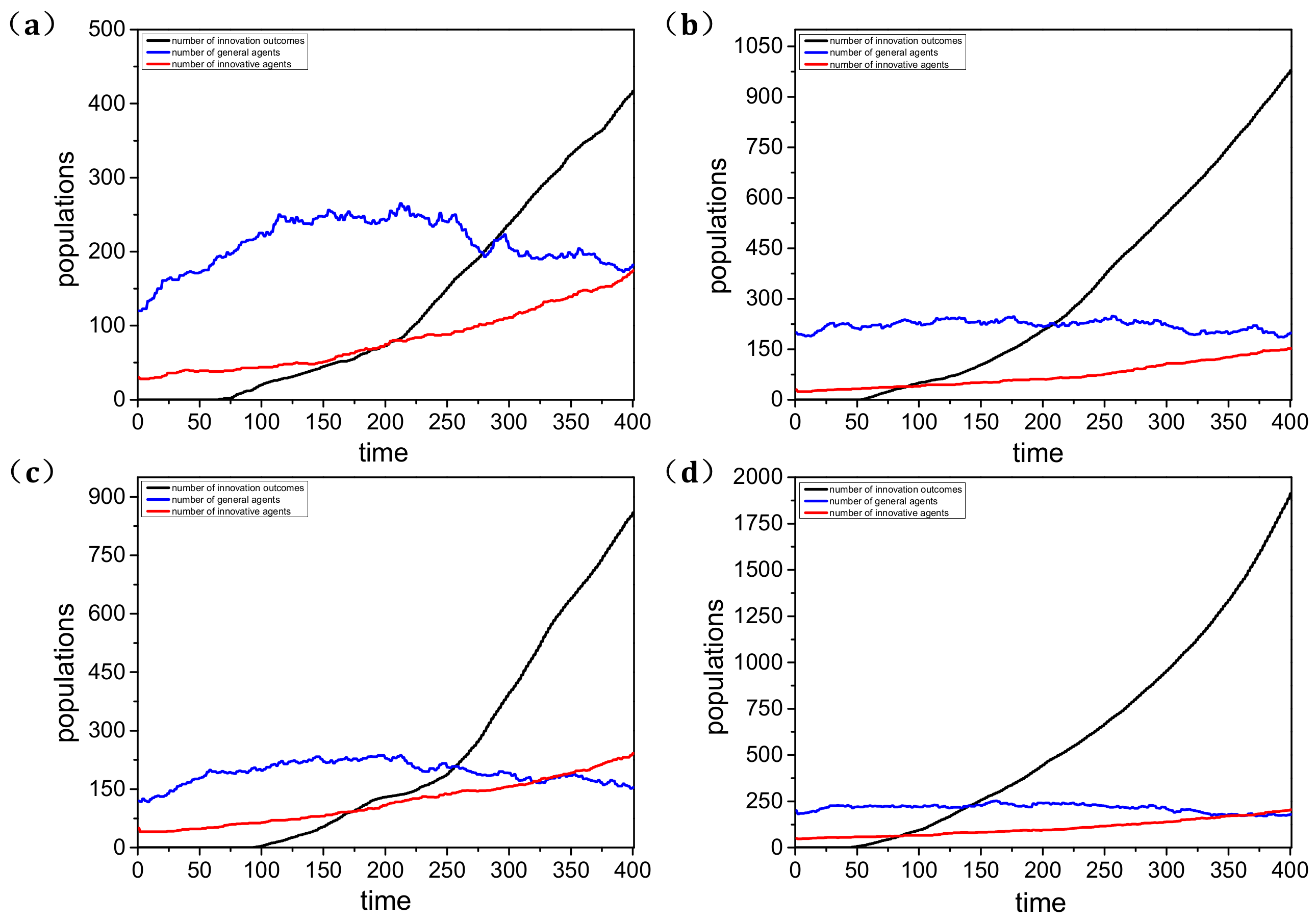
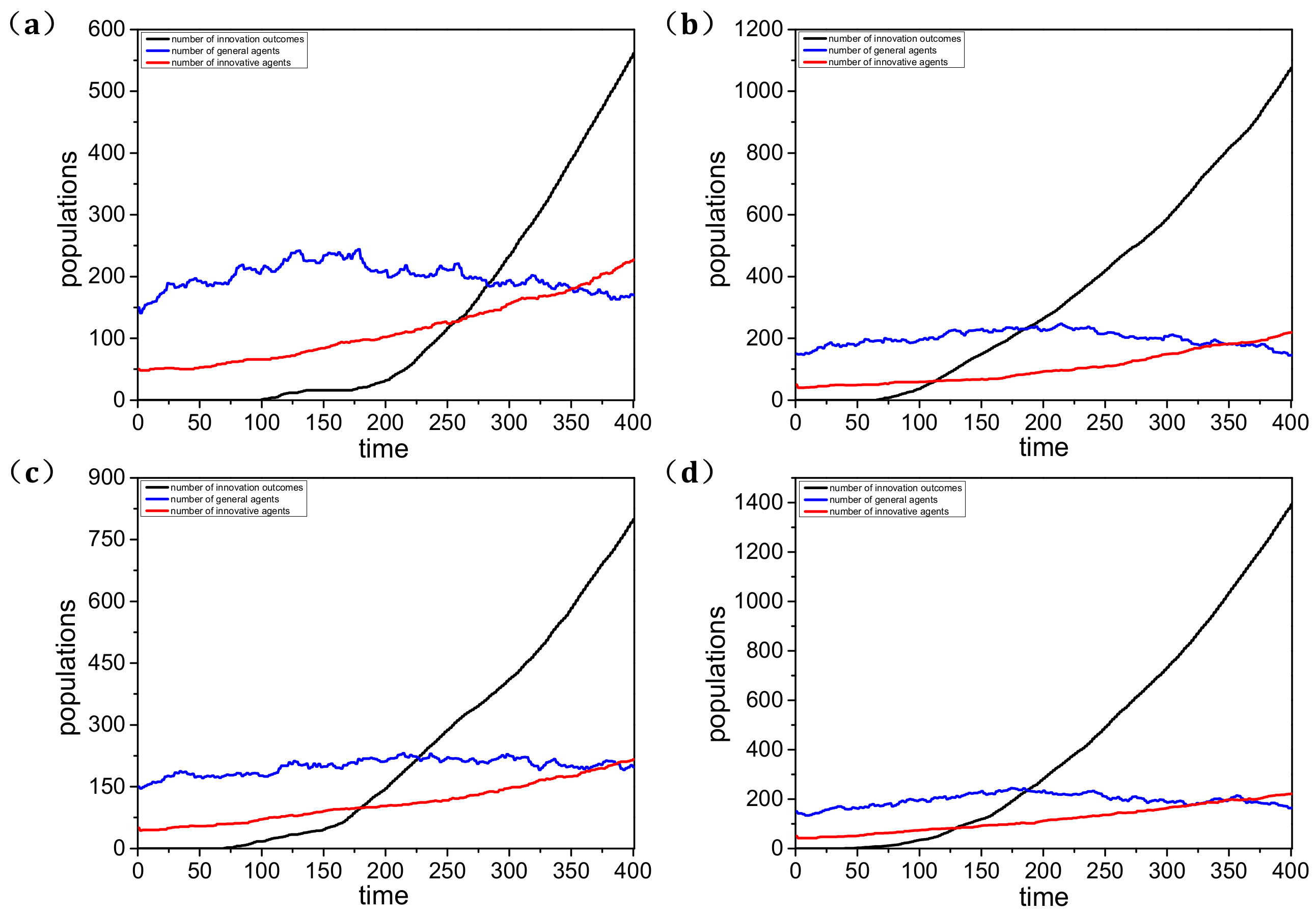
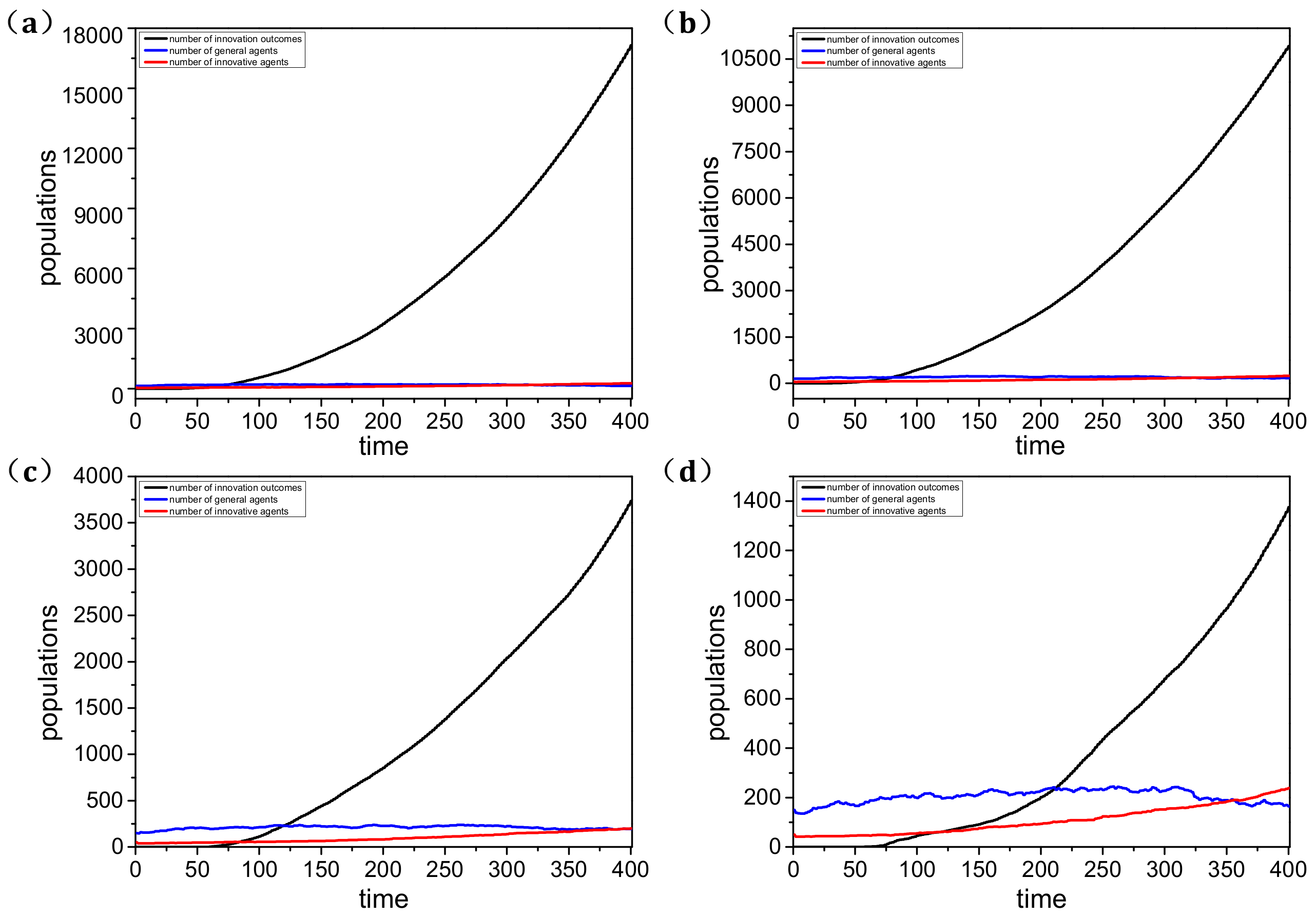

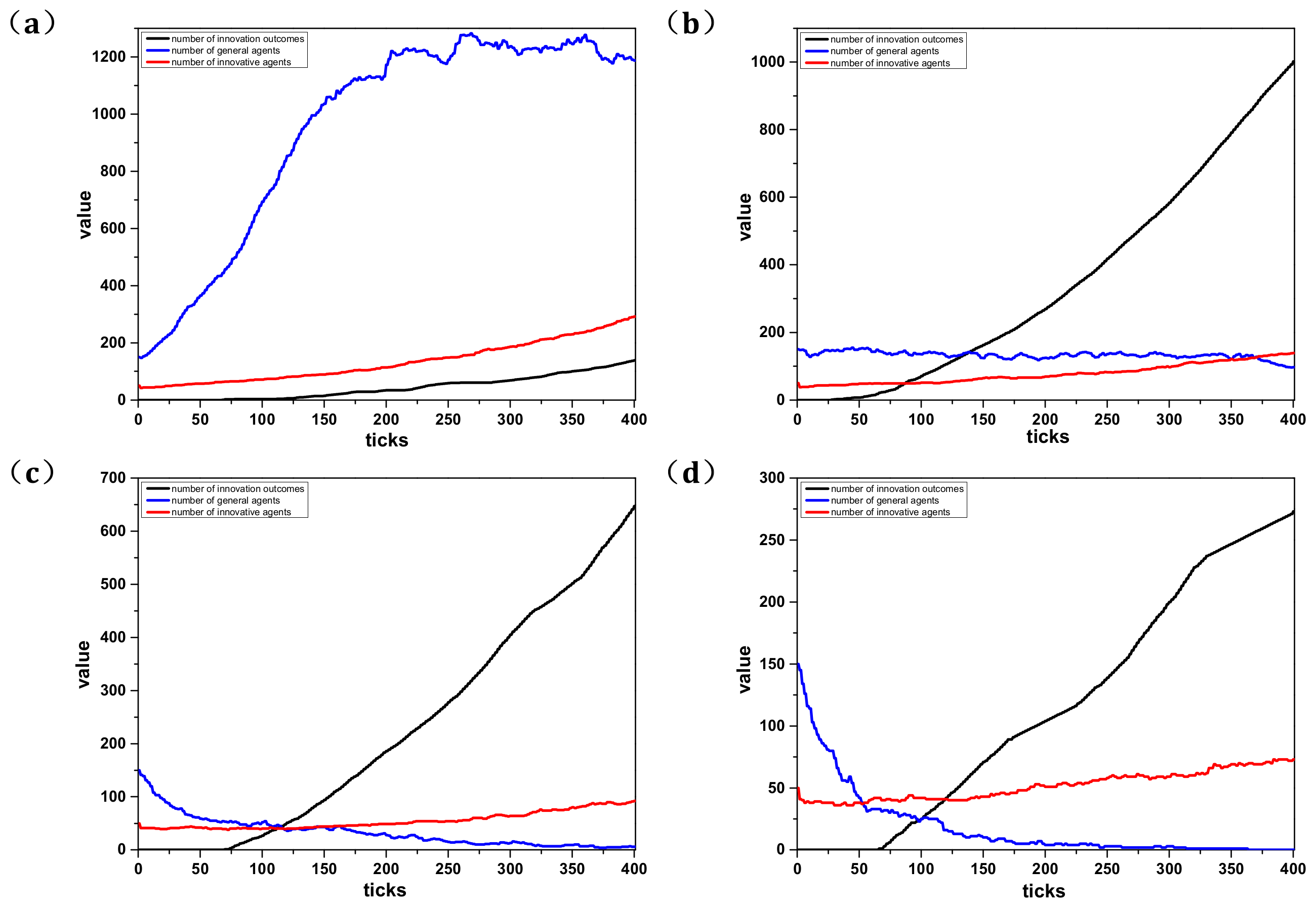
| Category | The Dominant Factor | Literature Sources |
|---|---|---|
| Innovation environment | Engineering requirements | [22,34,35,36] |
| Policy environment | [37,38] | |
| Innovation culture | [39,40,41] | |
| Innovation network organisation | organisation scale | [42,43] |
| Form of collaboration | [44,45] | |
| Agent Positioning | [3,46] | |
| Inter-organisational relationship | Cooperation basis | [47,48] |
| Recognition ability | [49,50] | |
| Communication | [51,52,53] | |
| Innovation resource management | Information sharing | [17,54] |
| Technology integration | [3,55,56] | |
| Knowledge absorption | [48,57] |
| Category | Parameter Name | Code | Range | Setpoint | Adjustable |
|---|---|---|---|---|---|
| Modelling environment | Technical maximum | Max-technology | 0–10 | 10 | Not |
| Information maximum | Max-information | 0–10 | 10 | Not | |
| Knowledge maximum | Max-knowledge | 0–10 | 10 | Not | |
| Engineering demand | Demand-value | 0–100 | 80 | Yes | |
| Policy environment | Environment-value | 0–100 | 80 | Yes | |
| Innovation culture | Experience & achievement-value | 0–100 | 80 | Yes | |
| Behavioral costs | metabolism | 0–20 | 6 | Yes | |
| General agent | Initial quantity | Initial-number-sheep | 0–150 | 150 | Yes |
| Growth rate (%) | Sheep-produce | 0–20% | 4 | Yes | |
| Absorptive capacity value in the grass | Sheep-gain | 0–1 | 0.2 | Yes | |
| Innovation agent | Initial quantity | Initial-number-wolves | 0–250 | 50 | Yes |
| Growth rate (%) | Wolf-produce | 0–1 | 1 | Yes | |
| Absorptive capacity value of grass | wolf-gain | 0–1 | 0.3 | Yes | |
| Absorptive capacity value of sheep | Wolf-gain-from-sheep | 0–1 | 0.4 | Yes | |
| Absorptive capacity of wolves | Wolf-gain-from-wolf | 0–1 | 0.5 | Yes | |
| Technical level difference | Value-k1 | 0–100 | 100 | Yes | |
| Information level difference | Value-k2 | 0–100 | 100 | Yes | |
| Knowledge level difference | Value-k3 | 0–100 | 100 | Yes | |
| Overall strength difference | Value-k4 | 0–100 | 50 | Yes | |
| Cooperative basic preference coefficient | a-contact | 0–10 | 3 | Not | |
| Recognition ability preference coefficient | b-recognition | 0–10 | 4 | Not | |
| Communication preference coefficient | c-relief | 0–10 | 3 | Not | |
| Evaluation standard | Standard-num | 0–20 | 80 | Yes | |
| Innovation outcomes | Innovation threshold | Innovation-threshold | 0–200 | 150 | Not |
| Innovation cost | Innovate-cost | 0–100 | 40 | Not |
Publisher’s Note: MDPI stays neutral with regard to jurisdictional claims in published maps and institutional affiliations. |
© 2022 by the authors. Licensee MDPI, Basel, Switzerland. This article is an open access article distributed under the terms and conditions of the Creative Commons Attribution (CC BY) license (https://creativecommons.org/licenses/by/4.0/).
Share and Cite
Zhao, N.; Lei, C.; Liu, H.; Wu, C. Improving the Effectiveness of Organisational Collaborative Innovation in Megaprojects: An Agent-Based Modelling Approach. Sustainability 2022, 14, 9070. https://doi.org/10.3390/su14159070
Zhao N, Lei C, Liu H, Wu C. Improving the Effectiveness of Organisational Collaborative Innovation in Megaprojects: An Agent-Based Modelling Approach. Sustainability. 2022; 14(15):9070. https://doi.org/10.3390/su14159070
Chicago/Turabian StyleZhao, Na, Congcong Lei, Hui Liu, and Chunlin Wu. 2022. "Improving the Effectiveness of Organisational Collaborative Innovation in Megaprojects: An Agent-Based Modelling Approach" Sustainability 14, no. 15: 9070. https://doi.org/10.3390/su14159070
APA StyleZhao, N., Lei, C., Liu, H., & Wu, C. (2022). Improving the Effectiveness of Organisational Collaborative Innovation in Megaprojects: An Agent-Based Modelling Approach. Sustainability, 14(15), 9070. https://doi.org/10.3390/su14159070








